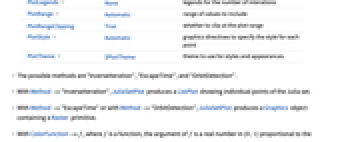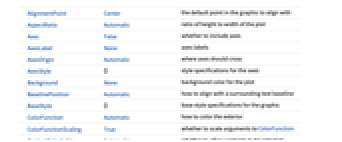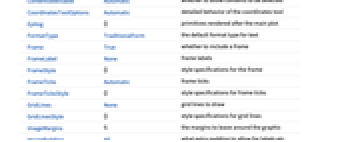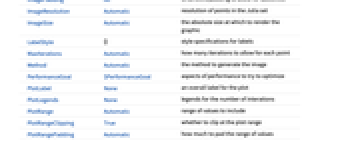JuliaSetPlot[f,z]
plots the Julia set of the rational function f of the variable z.
JuliaSetPlot[c]
plots the Julia set of the function ![]() .
.




JuliaSetPlot
JuliaSetPlot[f,z]
plots the Julia set of the rational function f of the variable z.
JuliaSetPlot[c]
plots the Julia set of the function ![]() .
.
Details and Options


- The Julia set of a function f is the closure of the set of all repelling fixed points of f.
- JuliaSetPlot has the same options as Graphics, with the following additions and changes: [List of all options]
-
AspectRatio Automatic ratio of height to width of the plot Axes False whether to include axes ColorFunction Automatic how to color the exterior ColorFunctionScaling True whether to scale arguments to ColorFunction Frame True whether to include a frame ImageResolution Automatic resolution of points in the Julia set MaxIterations Automatic how many iterations to allow for each point Method Automatic the method to generate the image PerformanceGoal $PerformanceGoal aspects of performance to try to optimize PlotLegends None legends for the number of interations PlotRange Automatic range of values to include PlotRangeClipping True whether to clip at the plot range PlotStyle Automatic graphics directives to specify the style for each point PlotTheme $PlotTheme theme to use for styles and appearances - The possible methods are "InverseIteration", "EscapeTime", and "OrbitDetection".
- With Method->"InverseIteration", JuliaSetPlot produces a ListPlot showing individual points of the Julia set.
- With Method->"EscapeTime" or with Method->"OrbitDetection", JuliaSetPlot produces a Graphics object containing a Raster primitive.
- With ColorFunction->f, where f is a function, the argument of f is a real number in
 proportional to the number of iterates, and f must return color directives, such as RGBColor and Hue, or named colors, such as Red and Blue.
proportional to the number of iterates, and f must return color directives, such as RGBColor and Hue, or named colors, such as Red and Blue. - ColorFunction->"name" is equivalent to ColorFunction->(If[#1,Black,ColorData["name"][#]]&).
- The list of possible color function names is given by ColorData["Gradients"].
- With ColorFunctionNone, the default color used by PlotStyle is given by ColorData["DefaultPlotColors",1].
-
AlignmentPoint Center the default point in the graphic to align with AspectRatio Automatic ratio of height to width of the plot Axes False whether to include axes AxesLabel None axes labels AxesOrigin Automatic where axes should cross AxesStyle {} style specifications for the axes Background None background color for the plot BaselinePosition Automatic how to align with a surrounding text baseline BaseStyle {} base style specifications for the graphic ColorFunction Automatic how to color the exterior ColorFunctionScaling True whether to scale arguments to ColorFunction ContentSelectable Automatic whether to allow contents to be selected CoordinatesToolOptions Automatic detailed behavior of the coordinates tool Epilog {} primitives rendered after the main plot FormatType TraditionalForm the default format type for text Frame True whether to include a frame FrameLabel None frame labels FrameStyle {} style specifications for the frame FrameTicks Automatic frame ticks FrameTicksStyle {} style specifications for frame ticks GridLines None grid lines to draw GridLinesStyle {} style specifications for grid lines ImageMargins 0. the margins to leave around the graphic ImagePadding All what extra padding to allow for labels etc. ImageResolution Automatic resolution of points in the Julia set ImageSize Automatic the absolute size at which to render the graphic LabelStyle {} style specifications for labels MaxIterations Automatic how many iterations to allow for each point Method Automatic the method to generate the image PerformanceGoal $PerformanceGoal aspects of performance to try to optimize PlotLabel None an overall label for the plot PlotLegends None legends for the number of interations PlotRange Automatic range of values to include PlotRangeClipping True whether to clip at the plot range PlotRangePadding Automatic how much to pad the range of values PlotRegion Automatic the final display region to be filled PlotStyle Automatic graphics directives to specify the style for each point PlotTheme $PlotTheme theme to use for styles and appearances PreserveImageOptions Automatic whether to preserve image options when displaying new versions of the same graphic Prolog {} primitives rendered before the main plot RotateLabel True whether to rotate y labels on the frame Ticks Automatic axes ticks TicksStyle {} style specifications for axes ticks
List of all options



Examples
open all close allBasic Examples (4)
Scope (7)
JuliaSetPlot[c] generates the Julia set of a function of the form ![]() :
:
Generate the Julia set of a polynomial:
Generate the filled Julia set of a rational function:
Show the points in the Julia set:
Use a theme with simple ticks in a high-contrast color scheme:
Options (71)
AspectRatio (4)
By default, the ratio of the height to width for the plot is determined automatically:
Use a numerical value to specify the height-to-width ratio:
Make the height the same as the width with AspectRatio1:
AspectRatioFull adjusts the height and width to tightly fit inside other constructs:
Axes (3)
By default, JuliaSetPlot uses a frame instead of axes:
AxesOrigin (2)
AxesStyle (4)
ColorFunction (3)
Frame (4)
JuliaSetPlot uses a frame by default:
Use FrameFalse to turn off the frame:
FrameLabel (4)
FrameTicks (9)
Frame ticks are placed automatically by default:
Use frame ticks on the bottom edge:
By default, the top and right edges have tick marks but no tick labels:
Use All to include tick labels on all edges:
Place tick marks at specific positions:
Draw frame tick marks at the specified positions with specific labels:
Specify the lengths for tick marks as a fraction of the graphics size:
Use different sizes in the positive and negative directions for each tick mark:
Specify a style for each frame tick:
Construct a function that places frame ticks at the midpoint and extremes of the frame edge:
FrameTicksStyle (3)
ImageResolution (1)
Increase ImageResolution for finer plots:
ImageSize (7)
Use named sizes such as Tiny, Small, Medium and Large:
Specify the width of the plot:
Specify the height of the plot:
Allow the width and height to be up to a certain size:
Specify the width and height for a graphic, padding with space if necessary:
Setting AspectRatioFull will fill the available space:
Use maximum sizes for the width and height:
Use ImageSizeFull to fill the available space in an object:
Specify the image size as a fraction of the available space:
PerformanceGoal (2)
PlotRange (2)
PlotStyle (2)
Ticks (9)
Ticks are placed automatically in each plot:
Use TicksNone to draw axes without any tick marks:
Use ticks on the ![]() axis, but not the
axis, but not the ![]() axis:
axis:
Place tick marks at specific positions:
Draw tick marks at the specified positions with the specified labels:
Use specific ticks on one axis and automatic ticks on the other:
Specify the lengths for ticks as a fraction of the graphics size:
Use different sizes in the positive and negative directions for each tick:
Specify a style for each tick:
Construct a function that places ticks at the midpoint and extremes of the axis:
Possible Issues (4)
JuliaSetPlot only works with rational functions:
When using orbit detection, sometimes no attractive orbits are detected:
If the value of the "Bound" method option is too low for a rational function, no points may be returned:
Related Guides
History
Text
Wolfram Research (2014), JuliaSetPlot, Wolfram Language function, https://reference.wolfram.com/language/ref/JuliaSetPlot.html.
CMS
Wolfram Language. 2014. "JuliaSetPlot." Wolfram Language & System Documentation Center. Wolfram Research. https://reference.wolfram.com/language/ref/JuliaSetPlot.html.
APA
Wolfram Language. (2014). JuliaSetPlot. Wolfram Language & System Documentation Center. Retrieved from https://reference.wolfram.com/language/ref/JuliaSetPlot.html
BibTeX
@misc{reference.wolfram_2025_juliasetplot, author="Wolfram Research", title="{JuliaSetPlot}", year="2014", howpublished="\url{https://reference.wolfram.com/language/ref/JuliaSetPlot.html}", note=[Accessed: 08-October-2025]}
BibLaTeX
@online{reference.wolfram_2025_juliasetplot, organization={Wolfram Research}, title={JuliaSetPlot}, year={2014}, url={https://reference.wolfram.com/language/ref/JuliaSetPlot.html}, note=[Accessed: 08-October-2025]}